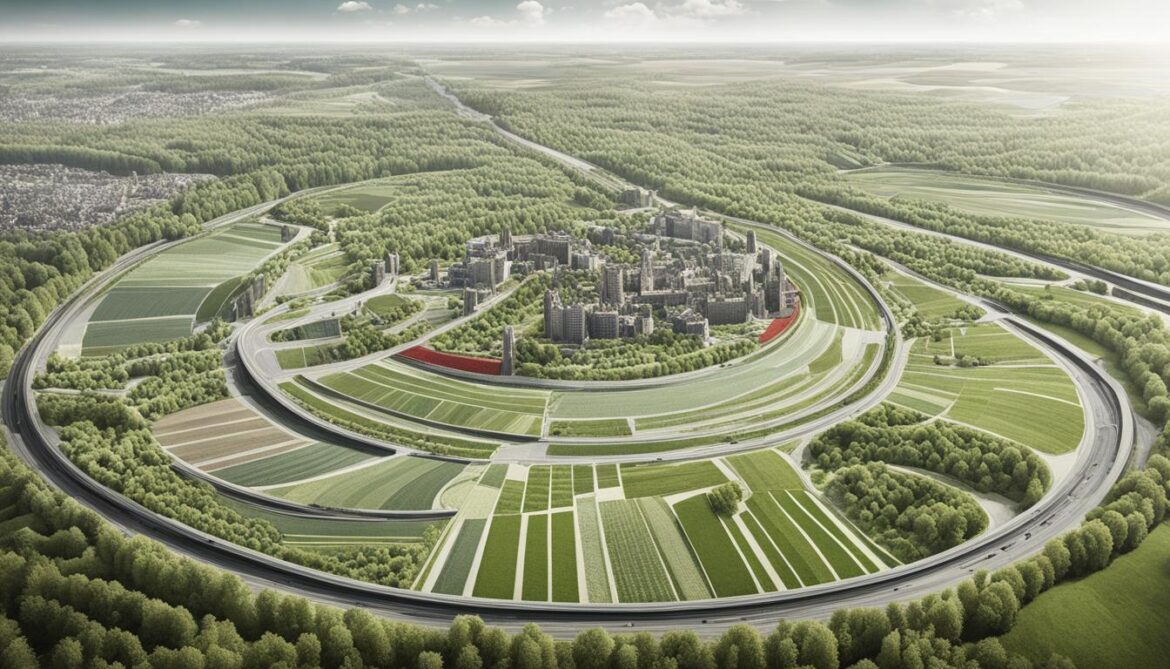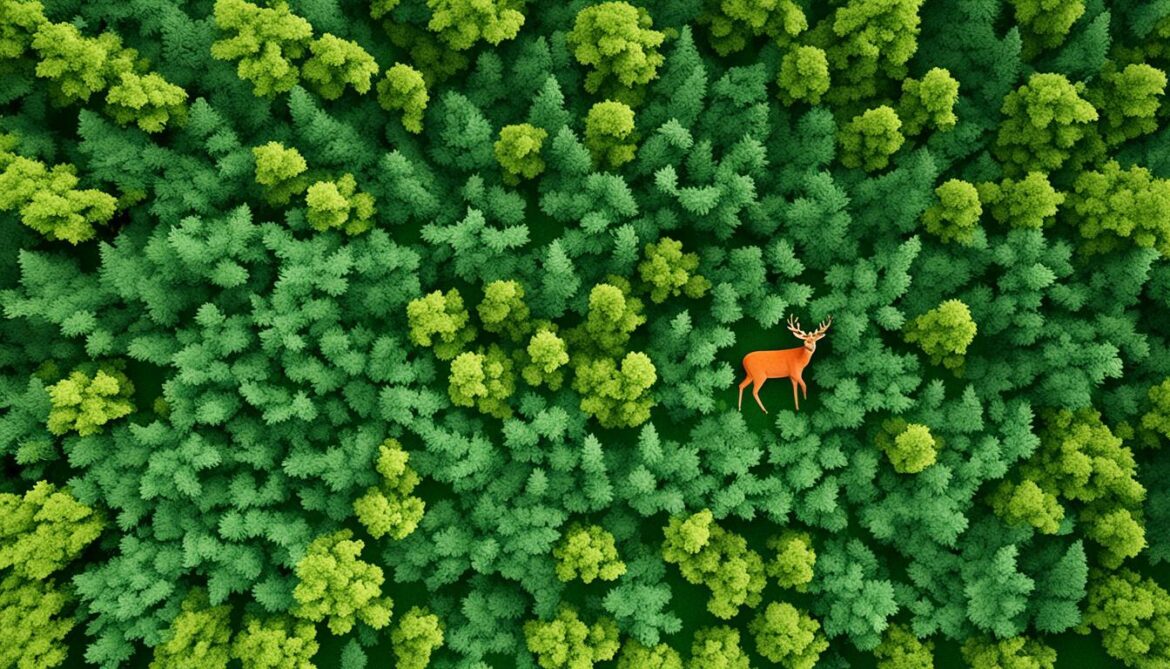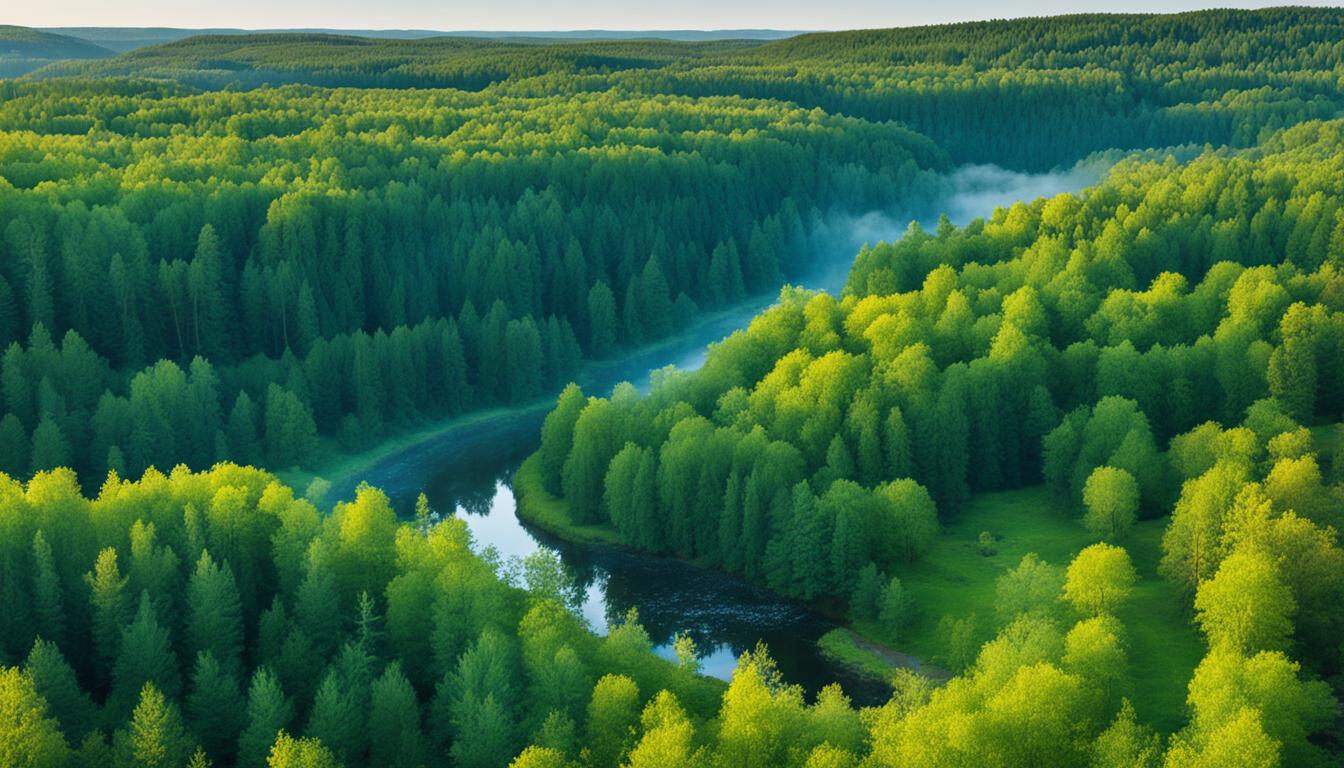Belgium Sacred Natural Sites and Biodiversity
Did you know that between 20% and 70% of species per main group of organisms in Belgium are threatened? That’s a staggering statistic that highlights the urgent need for biodiversity conservation in the country.
Belgium is home to a diverse range of species, with an estimated total of over 55,000. However, land conversion, pollution, invasive species, and climate change are putting immense pressure on its biodiversity. The consequences of losing these species and their habitats are far-reaching, impacting the delicate balance of ecosystems and the valuable services they provide.
Fortunately, Belgium has implemented measures to enhance biodiversity conservation, such as the National Biodiversity Strategy to 2020. In this article, we will take a closer look at the magnificent biodiversity in Belgium, the threats it faces, the efforts being made to conserve it, and the importance of valuing and protecting ecosystem services.
Key Takeaways:
- Between 20% and 70% of species per main group of organisms in Belgium are threatened.
- Land conversion, pollution, invasive species, and climate change are the main threats to biodiversity in Belgium.
- Belgium has implemented measures such as the National Biodiversity Strategy to enhance conservation efforts.
- Biodiversity valuation and the importance of ecosystem services are crucial for effective conservation.
- Collaboration and mainstreaming biodiversity policy across sectors are key to future conservation efforts in Belgium.
Magnificent Biodiversity in Belgium
Belgium’s geographical and geological characteristics, along with human impact on land use, have resulted in magnificent biodiversity. The country is home to an incredible variety of species, including vascular plants, bryophytes, macro-algae, vertebrates, carabids, butterflies, and dragon- and damselflies. This thriving ecosystem showcases the immense beauty and richness of Belgium’s natural heritage.
However, recent observation data reveals a worrying decline in many species, with some already declared extinct. This decline emphasizes the urgent need for conservation efforts to protect and restore Belgium’s unique biodiversity.
The Main Vegetation Types in Belgium
In Belgium, various vegetation types contribute to the diverse landscape. From lush forests to sprawling grasslands and vibrant wetlands, each habitat harbors a distinct range of species.
- Forests: Belgium’s forests provide essential habitats for numerous plants and animals, playing a crucial role in biodiversity conservation. These forests are home to many endemic and endangered species.
- Grasslands: The grasslands in Belgium support a wide variety of plant species, attracting a diverse range of insects, birds, and mammals. These habitats are important breeding grounds for numerous species.
- Heathlands: Belgium’s heathlands are characterized by their unique vegetation, including heathers and mosses. These habitats are home to specialized plant and animal species, with butterflies and bees being particularly abundant.
- Wetlands: Belgium’s wetlands, such as marshes and swamps, provide vital ecosystems that support a plethora of plant and animal life. These habitats are crucial for species diversity and act as important breeding and feeding grounds.
- Lakes and Rivers: Belgium’s freshwater bodies, including lakes and rivers, nurture a variety of aquatic life forms. They are teeming with fish, amphibians, and aquatic plants, forming important ecological corridors.
- Marine Ecosystems: In addition to its terrestrial habitats, Belgium also boasts diverse marine ecosystems in the North Sea. These ecosystems harbor an array of marine species and contribute to the overall biodiversity of the region.
By preserving and protecting these various vegetation types, Belgium can safeguard the habitats and species that rely on them. Conservation efforts are essential to maintain the delicate balance of Belgium’s ecosystems and ensure a sustainable future for its biodiversity.
Threats to Biodiversity in Belgium
In Belgium, the protection of wildlife habitats and environmental conservation face numerous challenges due to various threats to biodiversity. These threats include land conversion, pollution, invasive species, and climate change, which have adverse impacts on the natural ecosystems.
One of the primary threats is land conversion, driven by urban and industrial expansion, agriculture, infrastructure development, and tourism. This process leads to the loss, degradation, or fragmentation of habitats essential for the survival of diverse species. As natural areas are transformed for human purposes, the native flora and fauna within these habitats suffer significant consequences.
Pollution, including eutrophication, is another major threat to biodiversity in Belgium. The release of harmful substances into the environment imposes considerable pressure on both fauna and flora. The polluted air, water, and soil negatively affect the health and sustainability of various species, disrupting the delicate balance of ecosystems.
Belgium also confronts the detrimental effects of invasive alien species. These non-native plants, fish, amphibians, reptiles, birds, and invertebrates pose a significant danger to biodiversity. By outcompeting and displacing native species, invasive species contribute to the loss of indigenous flora and fauna, disrupting the intricate web of ecological relationships.
Furthermore, climate change exacerbates these threats and has a noticeable impact on biodiversity in Belgium. Rising temperatures, changing precipitation patterns, and extreme weather events alter the distribution and abundance of species, prompting shifts in their ecological niches. As habitats are transformed by these phenomena, some species may struggle to adapt or find suitable conditions for survival.

The preservation of Belgium’s precious wildlife habitats and the overall protection of the environment require concerted efforts to mitigate these threats. Implementing effective strategies for environmental conservation and actively engaging in sustainable practices are vital steps towards safeguarding the diversity of species and ensuring the resilience of ecosystems.
Measures for Biodiversity Conservation in Belgium
Belgium has implemented various measures to enhance Belgium wildlife habitats and promote Belgium biodiversity conservation. These initiatives aim to protect and restore the nation’s rich biodiversity and ensure the long-term sustainability of its ecosystems.
One key component of Belgium’s biodiversity conservation efforts is the National Biodiversity Strategy to 2020. Updated in 2013, this strategy provides guidance for revising federal and regional biodiversity action plans. It sets out clear objectives and targets for enhancing biodiversity conservation, emphasizing the importance of collaboration between different stakeholders.
Efforts have been made to achieve the Aichi Biodiversity Targets, a set of global goals adopted under the Convention on Biological Diversity. Belgium has established numerous protected areas to safeguard important wildlife habitats and ensure the preservation of critical ecological sanctuaries. These areas not only provide safe havens for threatened species, but also serve as research and educational sites.
Protecting and restoring degraded ecosystems play a vital role in Belgium biodiversity conservation. The restoration of degraded habitats has been a major focus, with the aim of improving the quality and connectivity of these ecosystems.
In addition to protected areas, Belgium has introduced incentives and support programs to promote sustainable practices and raise awareness about the importance of biodiversity. Agro-environmental measures and forest certification programs have had positive effects on biodiversity, encouraging land managers and forest owners to adopt environmentally friendly practices.
The integration of biodiversity criteria in public procurement policies reflects Belgium’s commitment to sustainable development. By promoting “green procurement,” the country seeks to encourage the use of products and services that promote biodiversity conservation and reduce environmental impacts.
Incentives and Support Programs for Biodiversity Conservation in Belgium
Belgium has implemented a range of incentives and support programs to encourage biodiversity conservation:
- Agro-environmental measures: These programs provide financial incentives and support to farmers who adopt practices that enhance biodiversity and protect wildlife habitats.
- Forest certification: Forest owners are encouraged to pursue forest certification schemes that promote sustainable forest management and preserve biodiversity.
- Research and innovation funding: Belgium invests in research and innovation projects focused on biodiversity conservation, seeking to develop new solutions and technologies.
- Education and awareness programs: Belgium prioritizes environmental education and public outreach, aiming to raise awareness about the importance of biodiversity and the need for its protection.
These measures, combined with ongoing efforts to integrate biodiversity considerations into various sectors, contribute to the overall goal of enhancing Belgium biodiversity conservation and promoting the sustainable use of the nation’s natural resources.

Importance of Ecosystem Services and Biodiversity Valuation
Belgium recognizes the importance of ecosystem services and the need for biodiversity valuation. Various studies have been conducted to assess the significance and value of biodiversity and the services provided by ecosystems. One valuable tool in this regard is the “Nature Value Explorer” website, which allows for the valuation of ecosystem services and the mapping of their socioeconomic importance.
Assessments have been carried out to understand the services provided by ecosystems in Flanders and the Walloon Region. For instance, a study conducted in the Walloon Region revealed that forest ecosystem services alone represent a value of over 6.5 billion euros.
The benefits of greening cities have also been identified, including climate mitigation, improvement of air quality, and the promotion of social cohesion. By incorporating green spaces and sustainable practices, cities can create a more livable environment while also enhancing biodiversity and ecosystem services.

Valuation of Ecosystem Services in the Walloon Region
The Walloon Region in Belgium has recognized the importance of valuing ecosystem services to promote sustainable decision-making and conservation efforts. The table below provides an overview of the estimated economic value of various ecosystem services in the Walloon Region:
| Ecosystem Services | Economic Value (in euros) |
|---|---|
| Flood regulation | 500 million |
| Water purification | 600 million |
| Carbon sequestration | 900 million |
| Provision of food and raw materials | 1.2 billion |
| Recreation and cultural services | 3 billion |
“Valuing ecosystem services not only helps us understand their importance but also provides a powerful tool for policymakers and stakeholders to make informed decisions that support biodiversity conservation and environmental protection.” – Belgian Environmental Agency
These assessments highlight the critical role of ecosystem services in supporting the well-being of both natural systems and human society. By recognizing and valuing the services provided by nature, Belgium can prioritize and implement effective strategies for biodiversity conservation and environmental protection.
Main Pressures on Biodiversity in Belgium
Belgium’s biodiversity faces significant pressures, driven by various factors including land conversion, pollution, invasive species, and climate change.
Land conversion poses a major threat as urban and industrial expansion, agriculture, infrastructure development, and tourism activities result in the loss, degradation, or fragmentation of critical habitats.
Pollution, particularly eutrophication, significantly impacts the environmental quality, imposing heavy pressure on both fauna and flora in Belgium’s diverse ecosystems.
Invasive alien species further contribute to biodiversity loss, introduced through various means such as trade, transport, and human activities. These species outcompete native flora and fauna, disrupting delicate ecological balances.
Climate change has a noticeable impact on biodiversity in Belgium, affecting the geographical range, phenology, and behavior of organisms. Temperature shifts, changing precipitation patterns, and extreme weather events pose challenges to the survival and functioning of various species and ecosystems.
To address these main pressures on Belgium’s biodiversity, effective environmental protection measures and conservation practices are crucial.

Impact of Land Conversion on Biodiversity
Land conversion for urbanization, industrial expansion, infrastructure development, and agricultural activities leads to the direct loss, degradation, or fragmentation of natural habitats in Belgium.
Pollution and its Effects on Flora and Fauna
Pollution, including eutrophication, negatively impacts the environmental quality of Belgium’s ecosystems, placing heavy pressure on the diverse flora and fauna.
The Threat of Invasive Species
Invasive alien species, introduced through various means, disrupt Belgium’s fragile ecosystems and contribute to the loss of biodiversity by outcompeting native species.
Climate Change and its Impact on Biodiversity
The effects of climate change, such as temperature shifts, changing precipitation patterns, and extreme weather events, significantly impact the geographical range, phenology, and behavior of organisms in Belgium.
| Pressure | Impact on Biodiversity |
|---|---|
| Land Conversion | Loss, degradation, and fragmentation of habitats |
| Pollution | Negative impact on environmental quality and flora and fauna |
| Invasive Species | Disruption of ecological balance and loss of native species |
| Climate Change | Shifts in geographical range, phenology, and behavior of organisms |
Implementation of the National Biodiversity Strategy in Belgium
Belgium has taken significant steps to enhance biodiversity conservation through the implementation of the National Biodiversity Strategy. This strategy, updated in 2013, aims to strengthen the implementation of the Convention on Biological Diversity. It focuses on various objectives, including tackling emerging risks, protecting and restoring biodiversity through the establishment of protected areas, and integrating the values of biodiversity and ecosystem services in development strategies.
“We believe that effective conservation and sustainable use of biodiversity are crucial for the well-being of our planet and future generations,” says Laura De Boeck, Director of the Belgian Biodiversity Platform. “The National Biodiversity Strategy serves as a roadmap to guide our actions and ensure that Belgium plays its part in global biodiversity conservation efforts.”
Belgium has taken concrete actions to achieve the Aichi Biodiversity Targets, which were established to halt the loss of biodiversity by 2020. For instance, permanent exhibitions on biodiversity have been established to raise awareness among the general public and promote a deeper understanding of the importance of conserving nature’s wonders. The launch of the Belgium Ecosystem Services Community has provided a platform for the development of innovative concepts, tools, and practices related to ecosystem services.
Protecting and Restoring Biodiversity
One of the key objectives of the National Biodiversity Strategy is the protection and restoration of biodiversity through the establishment of protected areas. Belgium has made significant progress in expanding its network of nature reserves, ecological sanctuaries, and other protected areas. These areas serve as crucial havens for threatened species and habitats, ensuring their long-term survival.
In addition, Belgium has been committed to restoring degraded ecosystems and promoting nature-based solutions. By restoring habitats and implementing conservation measures, the country aims to enhance biodiversity and ecosystem functioning, contributing to the overall health and resilience of ecosystems.
Integrating Biodiversity into Development Strategies
Recognizing the intrinsic value of biodiversity and the essential ecosystem services it provides, Belgium has made efforts to integrate these values into development strategies. By considering the benefits of biodiversity in decision-making processes, the country seeks to ensure that economic development is sustainable and does not come at the expense of nature’s treasures.
The integration of biodiversity into development strategies paves the way for more sustainable land use practices, responsible infrastructure development, and the promotion of green and blue spaces in urban areas. It also highlights the importance of considering ecological aspects in spatial planning, ensuring that wildlife habitats are preserved and connectivity between protected areas is enhanced.
Collaboration and Partnerships
The successful implementation of the National Biodiversity Strategy in Belgium relies on strong collaboration and partnerships among various stakeholders. Government agencies, research institutions, non-governmental organizations, and local communities work together to achieve the shared goal of biodiversity conservation.
The Belgium Biodiversity Platform serves as a coordination and communication hub, fostering collaboration among different actors and facilitating the exchange of knowledge and best practices. This platform acts as an important catalyst for innovation and the implementation of effective conservation strategies.

By implementing the National Biodiversity Strategy, Belgium demonstrates its commitment to conserving and protecting its unique biodiversity. Through the establishment of protected areas, the integration of biodiversity values in development strategies, and the collaborative efforts of various stakeholders, Belgium is striving to secure a sustainable future for its natural heritage.
Efforts to Achieve the Aichi Biodiversity Targets in Belgium
Belgium is actively working towards achieving the Aichi Biodiversity Targets in order to promote biodiversity conservation and protect ecological sanctuaries. Various initiatives and programs have been implemented to drive these efforts forward.
The Royal Belgian Institute of Natural Sciences has taken a significant step by opening a permanent exhibition hall dedicated to “Biodiversity in Cities”. This exhibition aims to raise awareness about the importance of biodiversity in urban areas and the need to preserve ecological sanctuaries. The institute plans to establish additional halls focusing on different aspects of biodiversity in the near future.
The Belgium Ecosystem Services Community is another important initiative that has been launched to develop concepts, tools, and practices for ecosystem services. This community aims to promote the integration of ecosystem services into policy and management decisions, supporting biodiversity conservation efforts. By recognizing the value and benefits of these services, Belgium is taking significant steps towards ensuring the long-term sustainability of its ecosystems.
Biodiversity criteria have also been included in public procurement policies in Belgium. By incorporating biodiversity considerations into the procurement process, the country is encouraging sustainable practices and supporting the conservation of ecological sanctuaries. This approach helps to ensure that biodiversity conservation is a priority in various sectors, further enhancing Belgium’s efforts in protecting its unique ecosystems.
Additionally, Belgium has implemented various incentives and support programs that contribute to conservation efforts. These initiatives provide financial assistance and resources to individuals, organizations, and communities working towards biodiversity conservation and the preservation of ecological sanctuaries. By offering support and encouragement, Belgium is fostering a collaborative approach to protecting its rich biodiversity.

Efforts in Perspective
The collective efforts implemented in Belgium to achieve the Aichi Biodiversity Targets demonstrate the country’s dedication to biodiversity conservation and the protection of ecological sanctuaries. By raising public awareness, developing innovative tools and practices, incorporating biodiversity criteria into policies, and providing support programs, Belgium is actively working towards a sustainable future.
| Efforts | Impact |
|---|---|
| Permanent exhibition hall on “Biodiversity in Cities” | Raises awareness and educates the public on the importance of biodiversity conservation in urban areas |
| Belgium Ecosystem Services Community | Develops concepts, tools, and practices for ecosystem services integration into policy and management |
| Inclusion of biodiversity criteria in public procurement policies | Encourages sustainable practices and supports the conservation of ecological sanctuaries |
| Incentives and support programs | Provides financial assistance and resources for biodiversity conservation efforts |
The combination of these efforts reinforces Belgium’s commitment to preserving its precious biodiversity and ensuring the long-term health of its ecological sanctuaries. Through collaboration and continued dedication, Belgium aims to make a positive impact on biodiversity conservation, not only for its own sake but also for the benefit of future generations.
Status of Biodiversity in Belgium
The state of biodiversity in Belgium reveals a concerning reality with a significant number of species under threat. The survival of more than a third of freshwater fish species, 28% of bird species, 23% of vascular plant species, and 21% of mammal species is at risk. Belgium biodiversity conservation efforts are crucial to ensuring their survival and the overall health of the ecosystem.
In both Flanders and Wallonia, the conservation status of habitat types and species of Community interest is disappointingly low. Although protected areas have increased in Belgium, strict levels of protection are lacking, posing a challenge to Belgium biodiversity conservation. Additionally, landscape fragmentation poses a significant threat to the interconnectedness of ecosystems, further endangering the sustainability of biodiversity.
Mainstreaming biodiversity policy into other sectors is an essential step forward. By integrating biodiversity considerations into land use planning, agriculture, and other industries, Belgium can better safeguard its precious wildlife habitats and promote a more sustainable future.
The Need for Strengthened Conservation Efforts:
In order to tackle the current challenges and preserve the rich biodiversity of Belgium, concerted efforts are necessary. Here are some key actions that can contribute to Belgium biodiversity conservation:
- 1. Protecting Threatened Species: Implementing targeted conservation measures for threatened species and their habitats is crucial for their survival and overall ecosystem resilience.
- 2. Enhancing Protected Area Management: Establishing effective levels of protection within existing and new protected areas will ensure the preservation of key biodiversity hotspots.
- 3. Promoting Landscape Connectivity: Conserving and restoring ecological corridors between protected areas will enhance habitat connectivity, enabling species to move and thrive.
- 4. Sustainable Land Use Practices: Encouraging sustainable agriculture, forestry, and urban planning practices can mitigate habitat loss and fragmentation, reducing the impact on biodiversity.
- 5. Public Awareness and Engagement: Promoting public awareness campaigns and engaging communities in conservation efforts can foster a sense of stewardship and support for biodiversity protection.
By addressing these challenges and fostering collaboration between stakeholders, Belgium can pave the way towards a more sustainable and biodiverse future.

| Threatened Species | Percentage at Risk |
|---|---|
| Freshwater Fish | Over a third |
| Birds | 28% |
| Vascular Plants | 23% |
| Mammals | 21% |
Protected Areas and Connectivity in Belgium
Belgium has made significant progress in the establishment of protected areas to safeguard its diverse natural landscapes and promote biodiversity conservation. The coverage of protected areas in the country is approaching the Aichi target of 17% of land area and has already exceeded the goal of 10% for coastal and marine areas. This demonstrates Belgium’s commitment to safeguarding its environmental treasures and preserving ecological sanctuaries.
However, despite the increase in protected areas, effective levels of protection remain a concern, particularly in marine and terrestrial environments. Further efforts are needed to ensure that these regions receive the necessary safeguards and conservation measures, allowing the flora and fauna within these regions to thrive undisturbed.
One crucial aspect in the conservation of biodiversity is the establishment of connectivity between protected areas. Belgium has been actively involved in regional cooperation to strengthen the connectivity of these areas, enabling the migration and movement of species across landscapes. This connectivity enhances the resilience and sustainability of ecosystems, maintaining a healthy and thriving natural environment.
The connectivity of terrestrial protected areas in Belgium is relatively high compared to other European Union (EU) countries, thanks to the commitment to regional collaboration. This interconnectedness is vital in preserving species diversity and promoting gene flow, allowing populations to mix and ensuring healthy genetic variability.
Protected Area Coverage in Belgium
| Type of Protected Area | Percentage of Land Area Covered |
|---|---|
| Terrestrial Protected Areas | 15% |
| Coastal and Marine Protected Areas | 12% |
The table above illustrates the coverage of protected areas in Belgium. While terrestrial areas have reached 15% protection, it is crucial to continue efforts to achieve effective protection in marine environments and increase coverage in all ecologically significant areas.
The image above showcases the breathtaking beauty of Belgium’s nature reserves, highlighting the rich biodiversity and serene natural landscapes found within these protected areas. These nature reserves serve as ecological sanctuaries, providing a safe haven for a wide range of plant and animal species.
Despite the progress made in protected area establishment and connectivity, Belgium still faces challenges in achieving effective protection and connectivity due to ongoing land conversion and landscape fragmentation. To address these challenges, it is essential to integrate biodiversity conservation into land-use policies and promote sustainable development practices.
Through continued collaboration and a comprehensive approach to conservation, Belgium can ensure the long-term preservation of its unique ecosystems and safeguard its valuable natural heritage for future generations.
Challenges and Future Directions for Biodiversity Conservation in Belgium
Belgium is committed to biodiversity conservation, but it faces several challenges in achieving this goal. The country must tackle issues such as land conversion, pollution, invasive species, and climate change, which negatively impact its rich biodiversity. These challenges require a multi-sectoral approach to mainstream biodiversity policy and ensure effective protection.
To address habitat loss, degradation, and fragmentation, Belgium needs to focus on reducing the conversion of natural habitats for urban expansion, agriculture, and other purposes. Efforts to address pollution, including eutrophication, are crucial to preserving the environmental quality that supports abundant fauna and flora. Additionally, combating the detrimental effects of invasive alien species is vital for safeguarding native biodiversity.
Furthermore, Belgium must adapt to the challenges posed by climate change and its impact on biodiversity. Changes in temperature and precipitation patterns affect the geographic range, phenology, and behavior of organisms, requiring adaptive strategies to ensure their survival.
To chart a future direction for biodiversity conservation, Belgium must align its National Biodiversity Strategy and regional biodiversity policies with the ambitious goals set out in the new EU Biodiversity Strategy for 2030. This alignment will create a cohesive framework and enhance Belgium’s contribution to broader international conservation efforts.
Collaboration and coordination among federal and regional authorities are essential for effective conservation measures. Engaging stakeholders, including researchers, NGOs, and local communities, will strengthen the collective effort towards biodiversity protection. By working together, Belgium can overcome these challenges and secure a sustainable future for its unique and valuable ecosystems.
Conclusion
Belgium’s sacred natural sites are vital for protecting the country’s diverse wildlife habitats and preserving its rich biodiversity. These sites serve as sanctuaries for a wide range of species, contributing to the maintenance of valuable ecosystem services. However, the conservation of Belgium’s natural heritage faces significant challenges, including the threats of land conversion, pollution, invasive species, and climate change.
To address these challenges, Belgium has implemented the National Biodiversity Strategy and is actively working towards achieving the Aichi Biodiversity Targets. This commitment demonstrates the country’s dedication to enhancing the protection and restoration of biodiversity. Collaboration and the integration of biodiversity policy into various sectors will be crucial for future conservation efforts.
By recognising the importance of sacred natural sites, promoting the establishment of nature reserves and ecological sanctuaries, and ensuring the preservation of spiritual landscapes, Belgium can continue its environmental protection endeavors. Protecting wildlife habitats and conserving biodiversity will not only benefit the ecosystems but also contribute to the overall well-being of the nation and its people.







